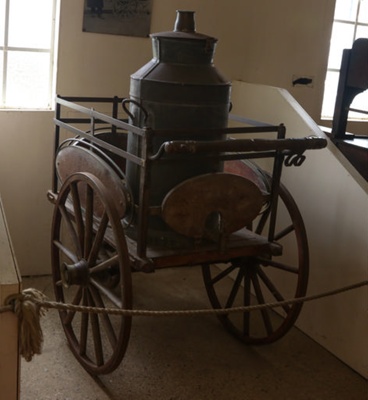Name/TitleMilk Trolley
About this objectA three wheel trolley with bracket to hold the milk churn and aperture in rear for the tap. It has hooks for the milk cans and a rim handle for propulsion. There is an oval plate, with an inscription on the front.
Further information was received from the donor, then aged 76, in April 1975. He went to Stowupland in 1929 and started a milk round in the village soon after, using a bicycle with two milk churns on each handle. The round grew quickly and he shortly acquired the trolley from a milk round in Ipswich. In addition to selling milk, at 2d a pint, he sold eggs, cream, in cartons and butter, 2/6 [12 1/2 p] per lb. These were carried in oblong lidded baskets on the front of the trolley, whilst the milk was carried in 12-gallon churn at the back of the cart. The milk was delivered by the donor after the morning milking (by hand with 12 cows). The skimmed milk was used for weaning calves and fattening pigs. About the beginning of the war the round had grown larger, and also he had bought a second round from Dick Pryke at Earl Stonham.
Bethan Huby, Research Volunteer:
Milk and dairy products were delivered to households, in urban and rural areas, alongside the commercialisation of dairy farms . Handcarts or ‘prams’, three wheeled carts with a milk churn, were used by milkmen in the 19th and 20th centuries, which delivered fresh produce twice or thrice daily . These deliveries were essential to local areas, as there was no refrigeration to store dairy products long-term . This is also why milk was transported in large churns and could only be distributed to customers via their own containers .
Between 1920 and 1939 handcarts were replaced by horse-drawn carts, and churns were gradually replaced with milk bottles. There were upgrades to milk bottles in 1935 and 1980, and cardboard tops were changed for aluminium ones during the 1940s. Refrigerators became popular in the 1920s and 1930s, however their installation in the home did not become affordable until the 1950s, and milk deliveries continued using electric milk floats. In the 1970s, over 18 million households had milk deliveries, compared to 2014 when only less than 5% of households received milk on their doorsteps.
At the end of the 1930s, Mr Allard’s milk round was successful, and he expanded into Earl Stonham, 4 to 5 miles south east from Stowupland . Mr Allard upgraded his trolley to a cart, with two ponies, delivering in Stowupland in the morning, and Earl Stonham in the afternoon. Eventually, the cart was also replaced by two motor vans, when the number of cows increased to 40, until the 1950s when Mr Allard retired from the milk rounds (March 31st 1952).
Milkmen were perceived as a family friend, a cheerful chappie, and known as the “eyes and ears of their community”. Notes were left in empty bottles and after collecting the money “the milkman would then be invited in for a cup of tea”. As a figure of familiarity across a village, a milkman would be at liberty to hear any gossip, and this gossip would likely travel between villages, for example when Mr Allard bought a second milk round in Earl Stonham.
Medium and MaterialsWood
Tyres: Iron
Rails: Brass
Hubs: Brass
Inscription and MarksOn a front plate:
R. ALLARD
STOWUPLAND
MeasurementsTotal height: 965mm
Height of base: 533mm
Height of sides: 431mm
Width: 609mm
Wheels Diameter Spokes
Side: 762mm 12
Front: 457mm 8
Length: 1140mm
Width: 785mm
Height: 1000mm
Object numberSTMEA:A.1251
Copyright Licence![]() Attribution - Non-commercial (cc)
Attribution - Non-commercial (cc)



